Most of us prefer growing fragrant flowers in our gardens. Which one you will choose for your garden will mostly depend on the weather in your region and the average temperature there. Plus, don’t forget to choose plants blooming at the particular time of the day you want to enjoy the most potent scent.
Regardless of whether you prefer tall, dwarf, woody, evergreen plants, there are fragrant ones for any scented garden, including yours. Let’s make your yard unique and magnificent by choosing the most beautiful flowers you have always dreamed of.
Most Fragrant Flowers & Shrubs for Your Garden
1. Lilac

Lilac (family Oleaceae) is a super-hardy flower originating from the Balkan Peninsula. Nowadays, many gardeners cultivate it throughout North America and Europe due to its scented, white, pink, or purple flowers. The plant is 5 to 15 feet (1.5 – 4.5 m) tall and 8 to 12 feet (2.5 – 3.5 m) wide on average.
Even though you can find seven colors of lilac, most gardeners grow common lilac. It blooms in the northern, colder parts of the US for approximately two weeks in late May. If you make a right combination of different lilacs, you may get a steady blooming for at least a month and a half.
2. Angel’s trumpet
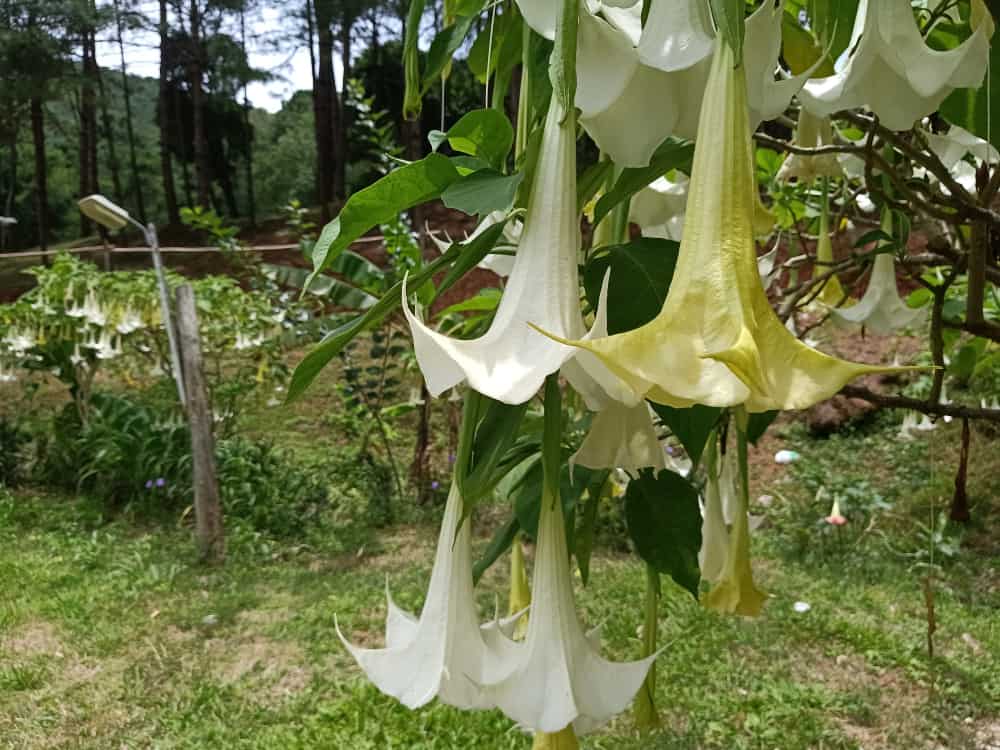
Angel’s trumpet is a woody-stemmed bush from the family Solanaceae originating from South America. Grow this hardy, evergreen plant if you live in a dry and warm region without danger of frost.
They are typically up to 25 feet (7.6 m) high and fragrant during the night when they attract insects for pollination. Beautiful trumpet-like, 20 inches (51 cm) long, white, yellow, greenish, cream, orange, pink, or red flowers hang like bells.
Angel’s trumpet will be an excellent decoration for your garden, but there is one catch. They are highly poisonous! Therefore, be careful and keep children and pets away from this unique beauty.
3. Daphne shrub

Renowned for alluring fragrance, this is one of the most favorite flowers of the contemporary perfume industry. Even though it originates from Japan and Korea, many gardeners around the world grow this 3 feet (0.9 m) tall winter plant.
Pick out any Daphne shrub between 75 to 90 existing species, and you won’t regret. You can expect it blooms in a quite short period somewhere between February and early March.
Growing this exotic plant will give you immense joy during the cold winter days and a possibility to enjoy its highly scented, white or pink flowers and red berries immediately after that. Just be careful since these bright berries are poisonous.
4. Rose

If you want a fragrant garden, you can’t avoid bushes of roses, a universal symbol of love. There are three primary groups of this beautiful flower.
They include hundreds of varieties of ‘old-fashioned, heirloom roses’ introduced before 1867, ‘wild roses’ grown for thousands of years, and ‘modern, hybrid roses’ presented after 1867.
This America’s favorite flower will bloom best in full sun and needs abundant watering. In turn, you can enjoy the fireworks of color, including pure white, elegant yellow, mysterious black, timeless red, even exotic blue or colorful varieties.
Be careful which variety you chose for your garden since they can be powerfully fragrant (floral, musky, fruity, or even citrusy) or without any scent at all.
5. Freesia

This elegant flower originating from South Africa is well-known for its charming, fruity, innocent fragrance. If you prefer a potent scent, pick out white or yellow variations of this fantastic herbaceous, perennial flower from the Iridaceae family.
When Christian Friedrich Ecklon described this genus in 1866, he named this exotic plant after the German botanist Friedrich Freese (1795 – 1876). Until these days, Freesia, with its unique funnel-shaped flowers, has become one of the most popular ornamental plants throughout the globe.
Flowers grow facing upwards, along one side of the stem, which provides the ideal, geometric look of that part of your garden or any floral arrangement you make.
6. Jasmine

Gardeners cultivate Jasmin for millennia. It is a national flower of Hawaii, Philippines, Indonesia, Pakistan, Thailand, and Syria. Moreover, the unofficial name of the Syrian city of Damascus is the ‘City of Jasmine.’
There are more than 200 species of this night-blooming, white flower, which is probably the most fragrant plant in the whole world. The modern perfume industry and aromatherapy can’t be imagined without the sweet, delicate scent of Jasmine.
Even though many people in Europe, the Americas, and Oceania grow this flower in their gardens, you can find the highest diversity of this plant in southern Asia.
7. Gardenia
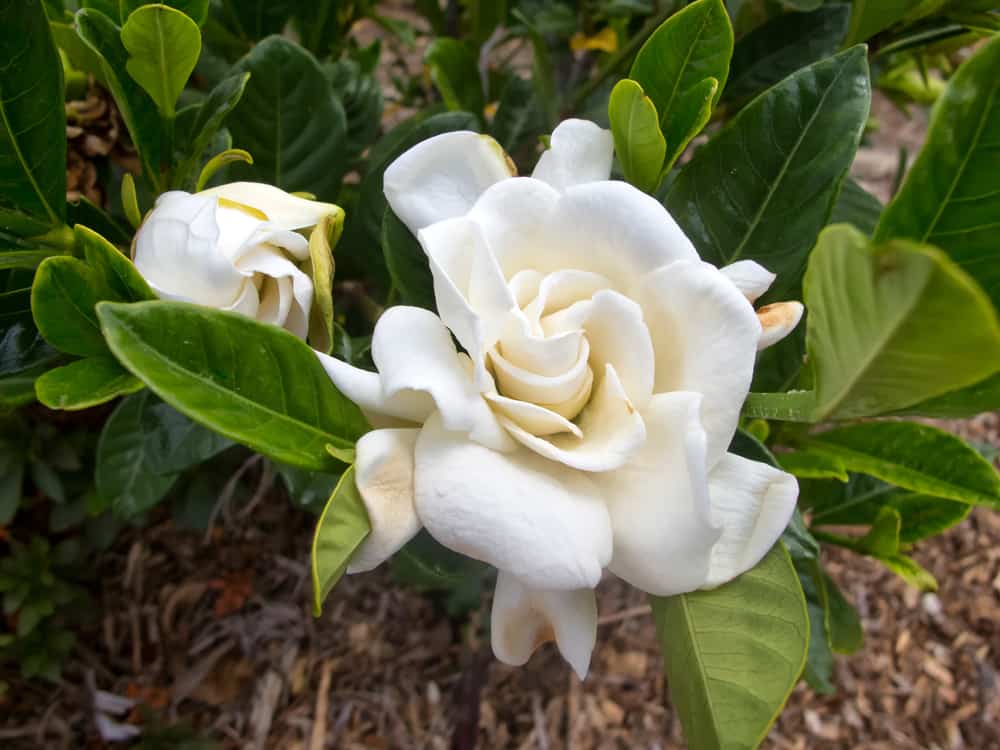
Gardenia is a highly popular flower from Rubiaceae family growing everywhere. Originated from tropical regions of Africa, Madagascar, the Pacific Islands, and Asia, it got its name after a Scottish-born American naturalist Dr. Alexander Garden.
The great thing is that you can grow this 3 to 50 feet (0.9 – 15 m) tall shrub both indoors and in your garden. That means that you can enjoy its white or creamy satin-like flowers regardless of whether you live in tropical or cold regions.
You will adore these large flowers blooming between mid-spring and mid-summer, and their magical scent which blends the surroundings perfectly.
8. Sweet Alyssum

Once you plant this enduring garden annual from the mustard family, you can expect to enjoy its blooming throughout the whole growing season. Originating from the Mediterranean, this heirloom overwinters is famous for dainty, honey-scented flowers.
Nowadays, this, 6 inches (15 cm) tall flower is quite common in many regions all over the US. The only thing you need to keep in mind when growing Sweet alyssum in your garden is to protect it from severe frost.
In general, you can expect the low-growing leaves surrounded by tiny, white, lavender, rose, or purple flowers blooming during summer and once again in fall.
9. Nicotiana
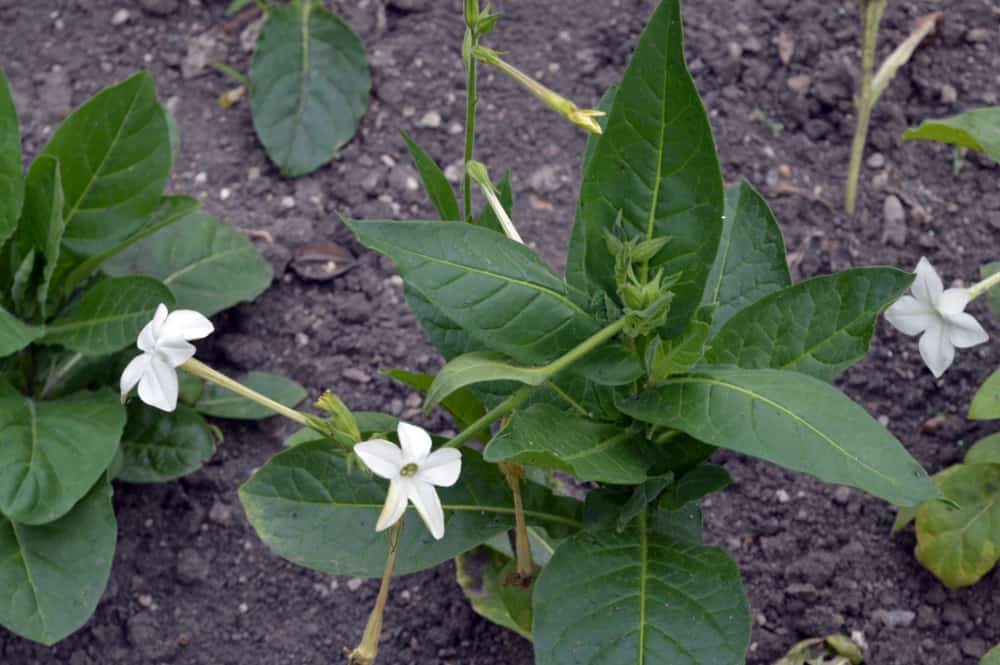
Nicotiana is herbaceous, 3 to 5 feet (0.9 – 1.5 m) tall shrub from the family Solanaceae indigenous to the Americas, southwest Africa, the South Pacific, and Australia. I like old-fashioned varieties with these small, tubular, fully fragrant flowers opening in the noon.
If you plant these fantastic flowers under the window of your bedroom, you will fall into the first dream with the most delicate and heady scent you have ever faced. Moreover, you can enjoy their beautiful, slightly sticky, white, yellow-green, or pink flowers throughout the day.
10. Lily of the Valley
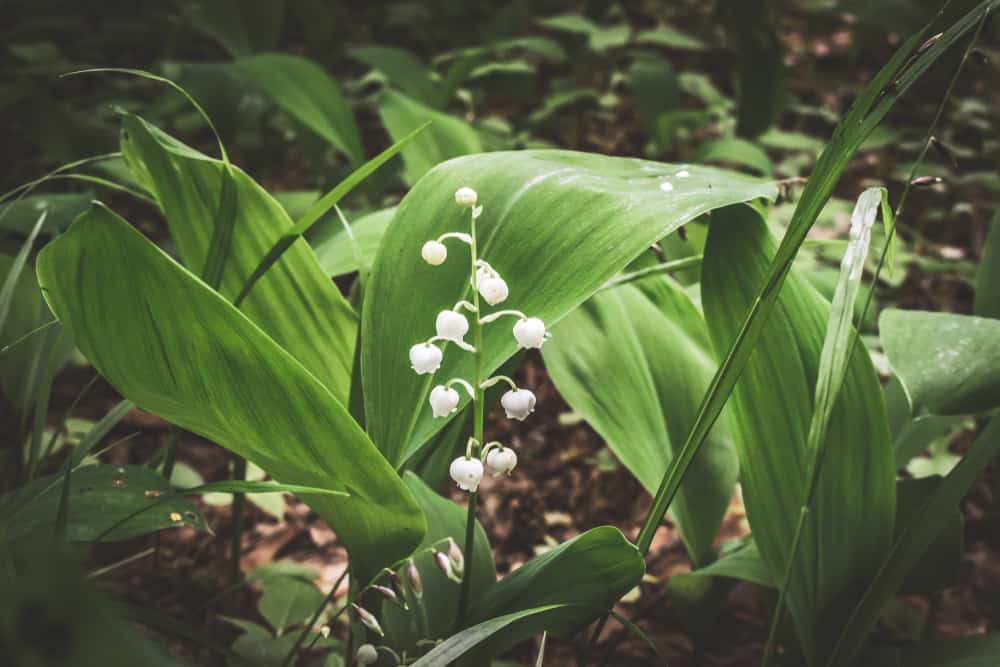
This impressive, 4 to 8 inches (10 – 20 cm) height flower from the Asparagaceae family is also well-known as Our Lady’s tears or May bells. You will probably notice that some perfumes containing this flower use its French name – Muguet.
Even though the sweet and seductive scent of the pendent, bell-shaped flowers will enchant you entirely, be careful. Namely, this plant native in Northern Europe and Asia is highly poisonous.
The Lily of the valley is actually a low growing plant, and many gardeners use it as a ground cover. There is one more thing. After full blooming, your plant will form red seed pods, which makes it attractive for a long time.
11. Honeysuckle

It is one of my favorite vanilla and honey-like fragrant flowers, approximately 40 feet (12 m) high. White, yellow, orange, pink, or red tubular, sweetly fragrant flowers produce honey-like nectar which attracts hummingbirds. Plus, elongated, red, blue, and black fruits are edible for most birds and wildlife.
Honeysuckle, which belongs to the family Caprifoliaceae, originates from the Northern Hemisphere and represents a perfect mix of a vine and shrub. Provide full sun and an adequate trellis as support for the twining varieties, and expect abundant and vigorous growth of this fantastic flower.
12. Abelia
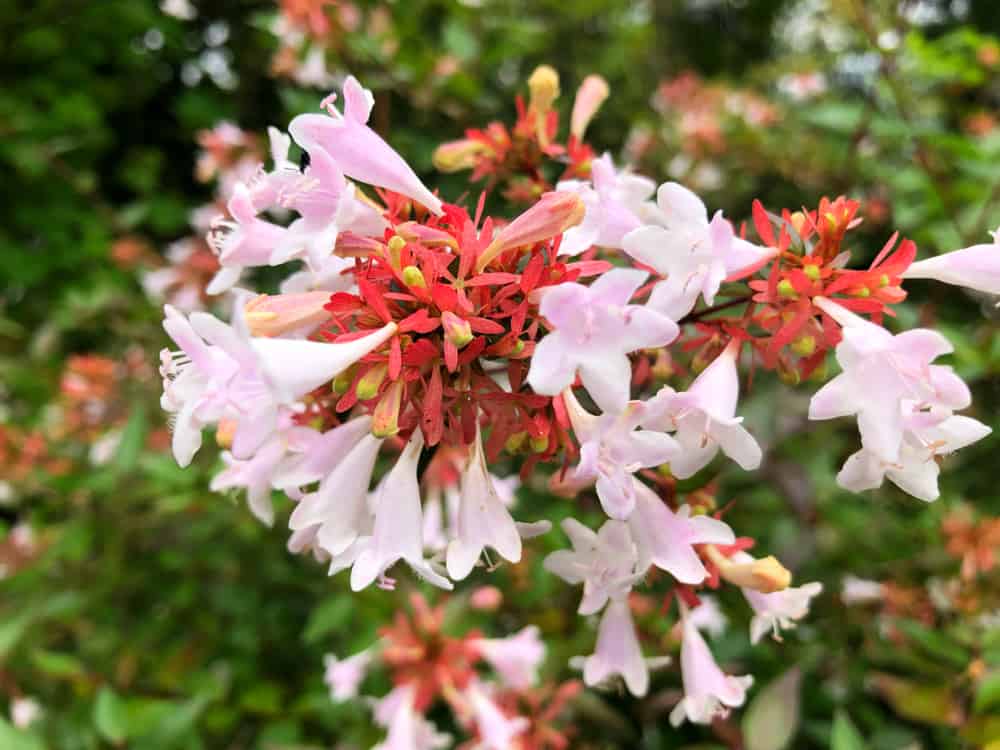
Depending on the variety, Abelia is a 3 to 20 feet (0.9 – 6 m) tall shrub originating from Japan and Mexico. It thrives in warm climates and blooms from late spring to autumn, but some new hybrids can stand colder weather as well.
If you plant it in your garden, you can enjoy its attractive, glossy, dark green leaves and pendulous, fragrant, white or pink, bell-shaped flowers. Keep in mind that red foliage of the evergreen Abelia is as beautiful as flowers of this plant are.
Once placed in your garden, it will attract colorful butterflies, and you will get a fantastic butterfly garden.
13. Butterfly Bush
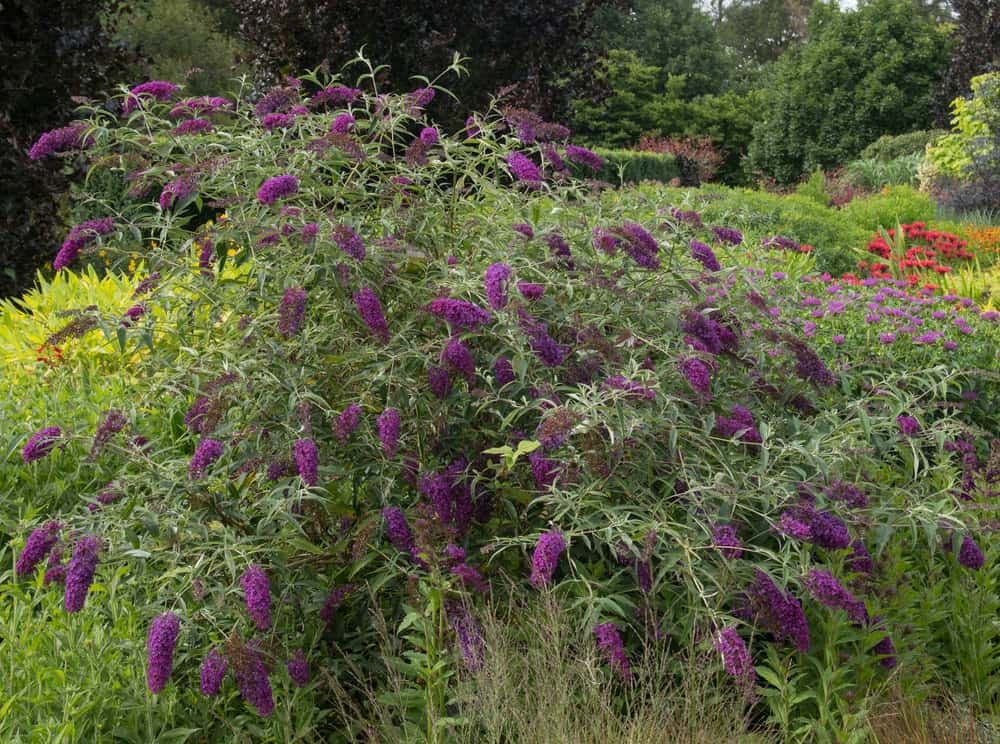
If you prefer flowers which grow without much day-to-day care but offer so much color and scent, Butterfly bush is a perfect choice for you. Plus, this shrub is a magnet for butterflies and hummingbirds.
The biggest issue will be to choose the right type for your garden since this plant can be from 2 to 16 feet (61 cm – 5 m) tall. Plus, it can produce a large variety of flowers, from spikes to clusters.
The botanist Adam Buddle was the first man who brought Butterfly bush from Asia to England in 1774. Since then, many people have appreciated this fantastic flower. However, many gardeners in the US consider it an invasive plant and even noxious weed.
14. Peony

The peony is a unique flower and the only genus in the Paeoniaceae family. It is a national flower of Serbia. Legend says that it grew from the blood of the knights killed during the Battle of Kosovo in 1389.
You simply must adore this shrubby, perennial, 1 to 3 feet (30.5 – 91 cm) tall plant with lush, flagrant, red or white flowers and glossy, compound, dark-green leaves.
Unfortunately, you can expect its extraordinary, precious blooming just in a short period between spring and early summer. Thanks to long hours of sunlight, Alaska offers ideal conditions for growing peonies even when they fade in other parts of the world.
15. Dianthus

Believe it or not, there are over 300 species of Dianthus. That 5 inches to 3 feet (13 – 91 cm) tall perennial from the Caryophyllaceae family originate from Europe and Asia.
Gardeners throughout the world grow these traditional, white, yellow, pink, red, or colorful flowers with marvelous sweet, vanilla-like fragrant. Some of the varieties of these low-growing plants have fantastic double flowers with many fringes which give them a special and unique appearance.
Surprisingly, it is not hard growing this beautiful flower in colder regions, even though it prefers full sun. Don’t forget that butterflies will love your garden thanks to these nectar-rich blooms.
16. Tuberose

Tuberosa (Agave Amica) is a perennial plant from Asparagaceae family native to Mexico. Thanks to its exotic, creamy, intoxicating floral fragrance, the extract of its white flowers is widely used in the perfume industry even though it is highly expensive.
If you prefer strong, seductive scents, pick up a few waxy flowers and fill the house with the natural fragrance for days. Find a place in your garden for these 3 feet (0.9 m) tall plants with 2.5 inches (6.3 cm) long white tubes separated into six flaring tepals (segments).
17. Iris

Pick out dwarf varieties, which are just 6 to 12 inches (15 – 30.5 cm) tall or giant ones reaching imposing 2 to 4 feet (61 cm – 1.2 m) high. All of them are abundant multipliers and don’t require too much care.
You can enjoy the blooming of Iris from the very beginning of spring to summer depending on the region you live in. In the US, the most common species is the tallest one, bearded iris.
Fragrant flowers can bloom colorful, white, yellow, blue, as well as purple to deep purple, almost black. Their smell can vary, and you can find these flowers with floral, anise, or fruity scent highly appreciated in the perfume industry.
18. Lavender

I was really pleased when finding out that both the pink, purple, or lilac flowers and silver-green leaves of this fantastic herb have a strong, aromatic scent. Frankly, this plant always reminds me of summers in southern France.
You can also bring a piece of Provance in your garden by planting this well-loved shrub from the Lamiaceae family. Plus, with this flower, your garden will become a home for numerous butterflies and bees.
This perennial reaches up to 2 feet (61 cm) height and can live about twenty years. Regardless of whether you put your lavender in a vase or sprinkle its flowers on the top of a cake, I promise that you will enjoy that fantastic scent.
19. Moonflower

Moonflower is 1 to 8 feet (30.5 cm – 2.4 m) annual with delicate, trumpet-shaped, white flowers and blue-green leaves. It blooms in summer and fall, but only during the night.
Many gardeners consider this old fashioned flower as the most romantic garden plant ever. I adore that lemon fragrance which overflows my garden at night while long, white petals unfurl slowly.
Once morning arrives, the flowers curl up, reverting to their closed form. Every morning I am surprised when noticing that my flowers are shyly closed, waiting for the next evening to open up again.
20. Southern Magnolia

Most of us grow this Southern tree because of the magnificent, exotic scent of white, yellow, pink, red, or purple flowers. You can enjoy these 12 inches (30.5 cm) long blooms every fall. Not to mention the beautiful, shiny, evergreen foliage, and amazing red fruits.
This large tree, originating from the southeastern US, usually reaches 60 to 90 feet (18 – 27.5 m) high. French botanist Pierre Magnol was the one who brought the first plant in Europe. Believe it or not, with its impressive height of 122 feet (37 m), the largest Southern Magnolia grows in Mississippi.
If you wish to grow this tree in your garden and enjoy its fragrant flowers, you need to protect it from frost and winter winds.
21. Daffodil

If you want to have a highly fragrant garden in early spring, you need to plant white, yellow, or orange Daffodils. Their cup-shaped blooms are a sure sign that my favorite season has come.
It is considered that there are approximately fifty species of this beautiful flower originates from the Iberian Peninsula. Its name ‘Narcissus’ is probably connected with the Greek word ‘narcotic,’ meaning – intoxicated.
Except in the hottest regions, these 2 to 30 inches (5 – 76 cm) high perennial grow throughout the US. You can choose to plant them between ornamental shrubs or along the pavement as well.
Summary
In general, it is not too hard to introduce the scent into your garden and get ultimate pleasure in the most natural way possible. When you decide to add some fragrant flowers, you should consider a few essential things.
The first thing you should do is to pick out the right plant for your USDA Hardiness Zone. Then, take care to choose the right place. Provide enough sun and shade for your plants, depending on the species you want to grow.
In the end, always keep in mind that flowering shrubs should be the base of your garden. They will attract butterflies and pollinators, as well as provide color and enjoyable scent all around.

Leave a comment